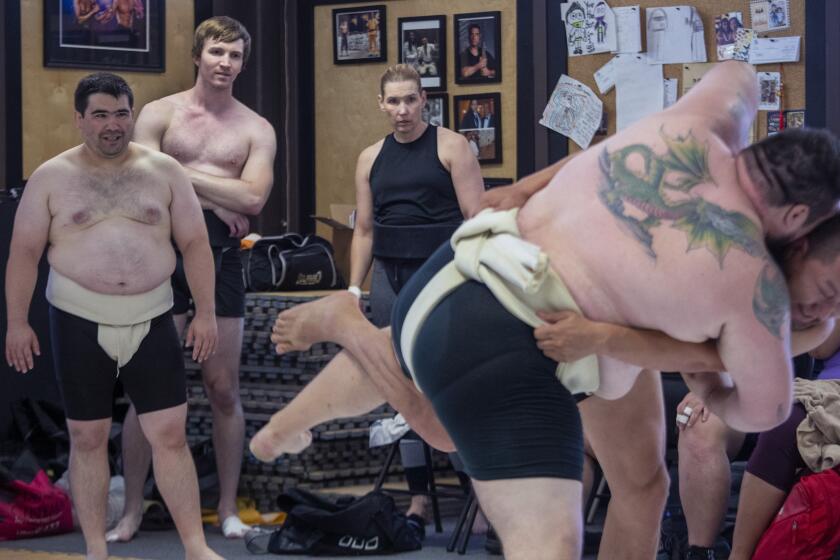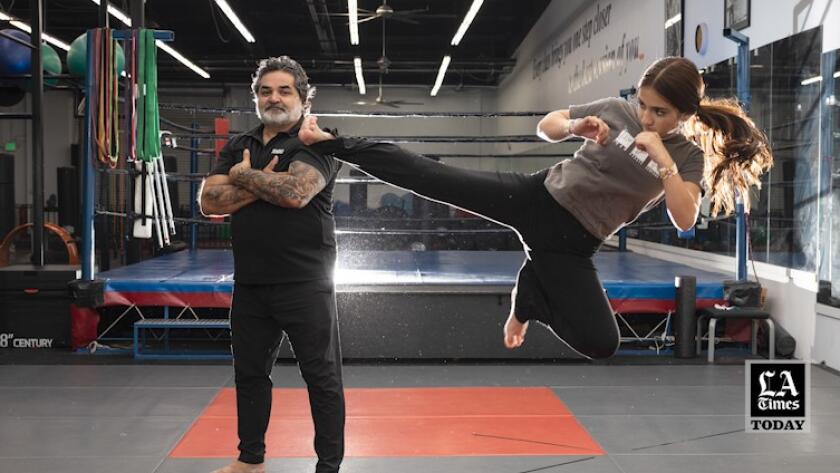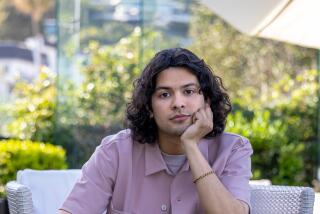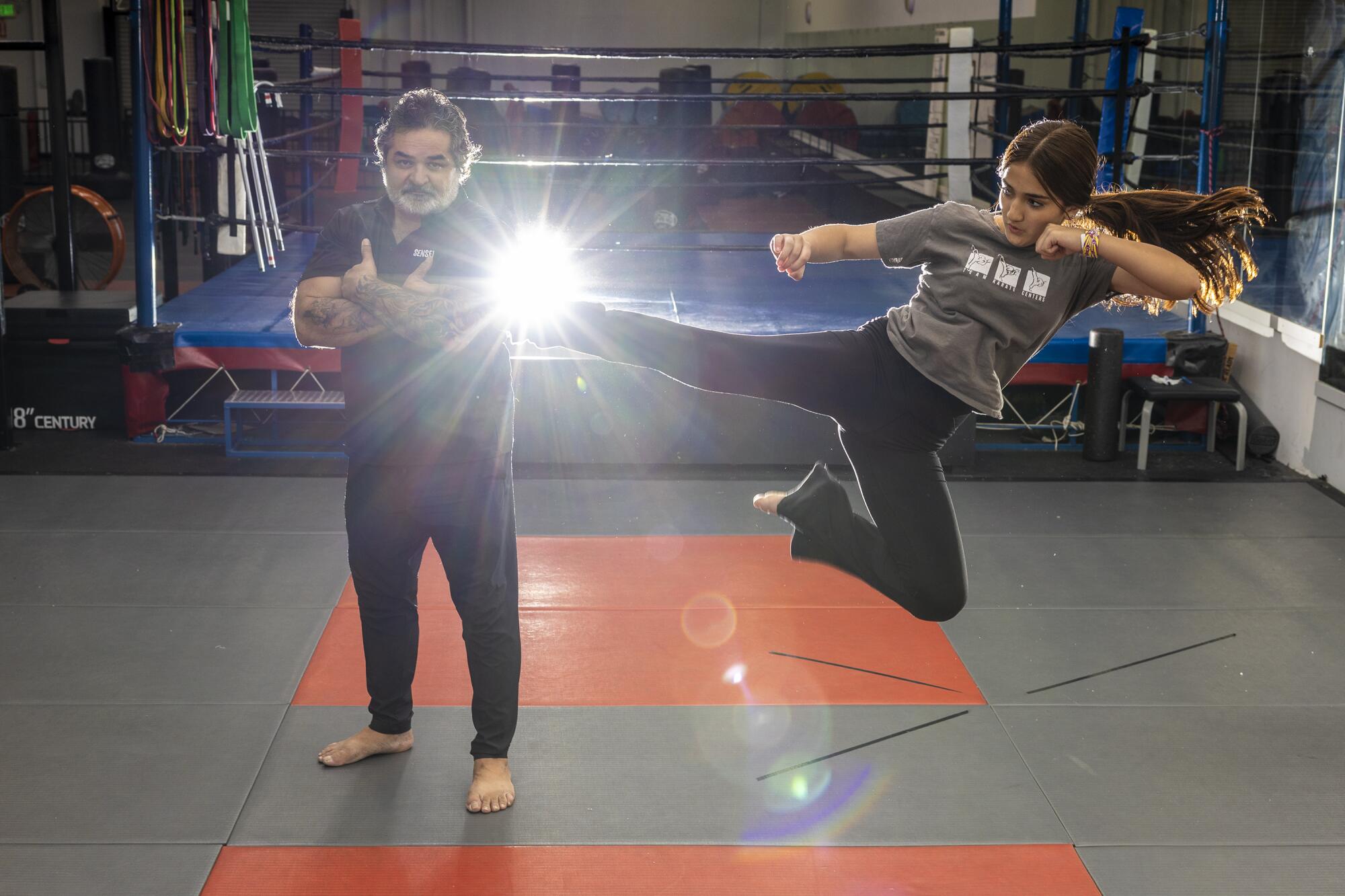
The music stops as the knives are passed out.
In a Woodland Hills strip mall off Victory Boulevard, tucked into a corner unit next door to an appliance outlet store and school uniform retailer, the voice of karate instructor Nima Elie echoes around a 7,000-square-foot studio.
“If you have a weapon,” he announces to his class of 8-to-10-year-olds, sitting quietly before him with green, blue and brown belts tied around their waists, “you do not mess around!”
And with that, the Tuesday night class at Team Karate Center begins.
There aren’t real knives being wielded, only harmless plastic props used for a self-defense drill. But at Team Karate Center, one of the oldest martial arts schools in the San Fernando Valley, the point is to remind the young students about the seriousness of their training, to keep them focused as they pair up and practice how to defend themselves with forearm blocks and disarm an attacker with a swift strike of their hand.
If this all seems right out of a Hollywood script — motivational messages on a wall, kids sparring amid a chorus of “hi-yas!” and instructor commands, the duality of an artform that promotes aggression while also teaching its students how to harness it — that’s because it sort of is.
It might not be an exact reflection of “Cobra Kai,” the hit Netflix series that rebooted the beloved “Karate Kid” movies of the 1980s and has returned the ancient martial art to the forefront of pop culture. But the parallels are impossible to ignore.
Returning guest stars from the ‘Karate Kid’ films and shifting perspectives all add to the series’ cheeky humor.
“The goal of all martial arts, in my opinion, is developing your competency and your character,” says Fariborz Azhakh, the 60-year-old sensei who has run Team Karate Center for four decades. “To develop those two things together, through technical moves and through understanding violence.”
And as the show, which just released its fifth season and has garnered millions of fans around the world, continues to grow in popularity and influence, the karate community hopes it will benefit as well.
“‘Cobra Kai’ and ‘Karate Kid’ made it real, so people could relate to it,” Azhakh explains. “As far as I’m concerned, it was the two biggest things that drew martial arts students to our schools.”
Josh Heald, a co-creator of the “Cobra Kai” series, was never one of those karate-obsessed kids. Neither were his two partners on the show, Jon Hurwitz and Hayden Schlossberg.
“I took karate in a dojo for a few weeks when I was a kid,” Heald said with a laugh. “But I remember not even lasting long enough to get a gi. And I don’t think Jon and Hayden even made it that far.”
As children of the ‘80s, however, the themes of the “Karate Kid” movies still resonated with them.
The conflict between metaphysical and militaristic teaching styles. The tension of learning violence and understanding when to use it. And the underdog story of Daniel LaRusso, the teenage protagonist who fights with honor and respect, overcoming his rival, Johnny Lawrence, who has mastered karate’s physical skills but not its morality.
“It has a ‘Rudy’-like quality to it,” Heald said. “If you apply yourself to this, and you practice and fight in a smart way, you can outwit an opponent and be successful without being of larger size. I think that’s what’s immediately accessible about it.”
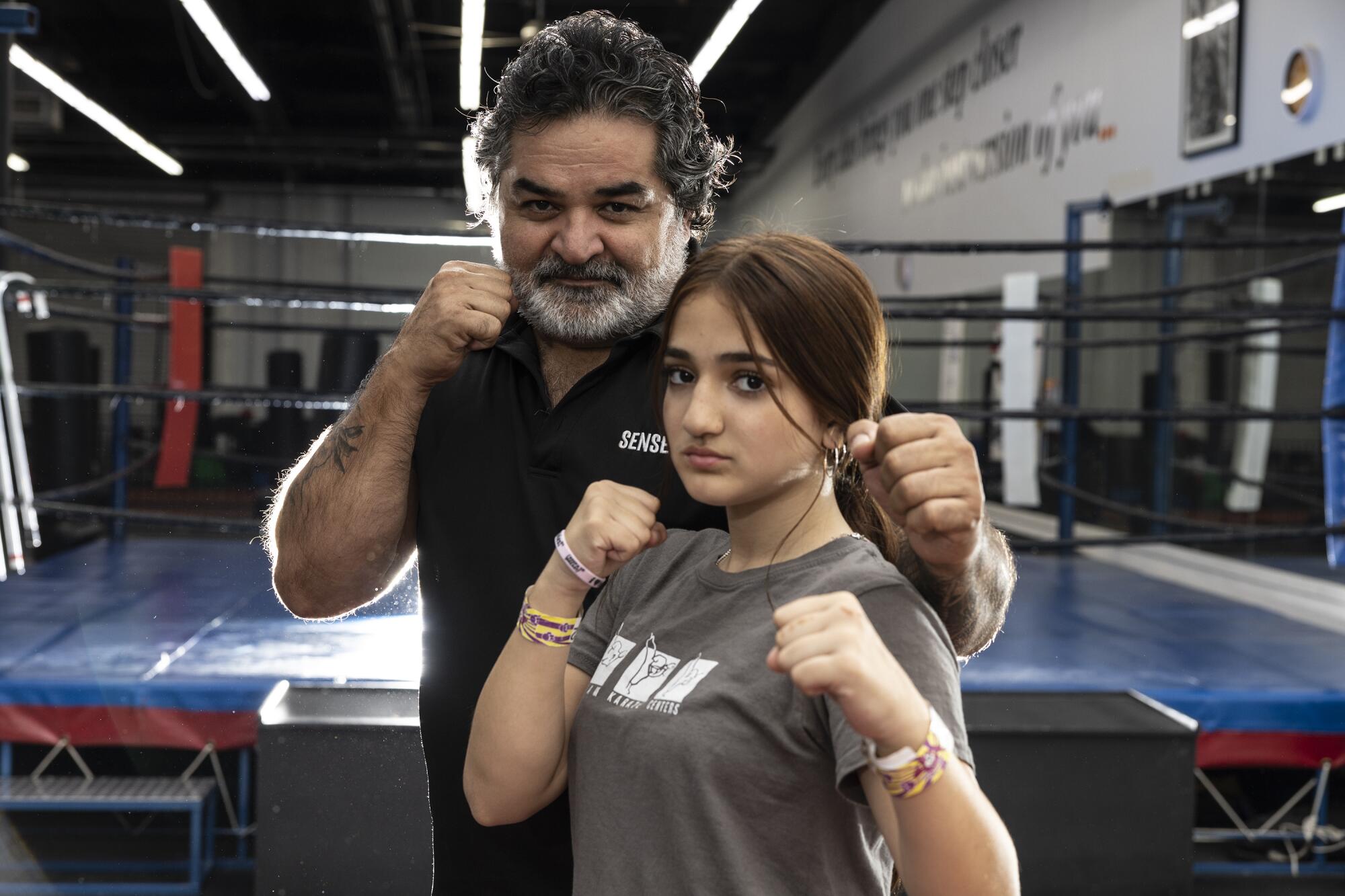
That’s what made the trio determined to create the spinoff “Cobra Kai” show, in which Ralph Macchio and William Zabka reprise their roles of Daniel and Johnny, respectively, now as adults instructing a new generation of karate students in the Valley.
After attracting millions of views through its first two seasons in 2018 and 2019, which aired on YouTube Premium, the show moved to Netflix and quickly became one of the streaming service’s most-watched titles. The fourth season reportedly garnered more than 120 million hours viewed in its first three days on the platform, when it was released at the start of the year.
Season 5 dropped Sept. 9, eagerly anticipated by a worldwide audience again.
A show about teenage karate warriors, “Cobra Kai” offers insights on repentance, redemption, forgiveness and unity in the face of existential evil.
“I would say karate is the best sport to be telling the personal and philosophical lessons we’re exploring on the show,” Heald said. “It teaches you all of those wonderful lessons of balance and respect and confidence, things that are so important to lead to well-roundedness when you’re a teenager or pre-teen and you’re coming into your own.”
Four decades ago, the original “Karate Kid” helped introduce the sport to pop culture. Martial arts had been practiced in the United States for decades, often in commercialized martial arts schools run by servicemen who had learned versions of the discipline while stationed throughout the Pacific during and after World War II.
But it was portrayals on film and television that exposed it to a wider audience, such as the 1971 western “Billy Jack,” David Carradine’s hit “Kung Fu” series on ABC and the films of Bruce Lee.
“It was the movies that changed martial arts forever,” said Michael Matsuda, president of the Burbank-based Martial Arts History Museum.
“Cobra Kai” star Ralph Macchio full interview with the Los Angeles Times.
No film had a greater impact than “The Karate Kid” in 1984, a blockbuster hit set in the Valley that offered a relatively realistic representation of karate’s real-world application.
“It kind of let people know [karate] was something they were capable of,” said Bob White, who was an advisor on the film and runs a karate school in Orange County.
Added Azhakh: “Our business just blew up. It brought a whole different level of education for parents: ‘Oh, maybe instead of soccer and baseball, we should put them in karate now.’ The kids thing became bigger than adults.”
Like many of his students, Azhakh’s first introduction to martial arts came in front of a screen.
During his childhood in Iran in the early 1970s, Azhakh and his older brother would go to the movies almost every Friday. And one week, their theater was showing “Enter the Dragon,” the iconic 1973 spy thriller starring Lee as an undercover agent and martial arts master.
It didn’t matter that the film was in a different language, translated through subtitles. Azhakh felt an immediate connection, drawn in by “the presence, the movements, everything about the movie,” he said.
Jenni and Josh Crook are a mother-son duo who will represent Torrance’s Yamamoto Sumo Dojo at the U.S. Sumo Open in Long Beach during the weekend.
Azhakh began practicing karate after moving to Southern California as a teenager, first attending a karate school in Canoga Park. He earned his first black belt, became an instructor and before long took ownership of his own dojo.
It wasn’t the most glamorous job. In order to buy his school, Azhakh gave up his new yellow Toyota Celica. He worked a day job as a waiter before teaching classes at night. And after the landlord at his original studio hiked the rent, he had to move several times.
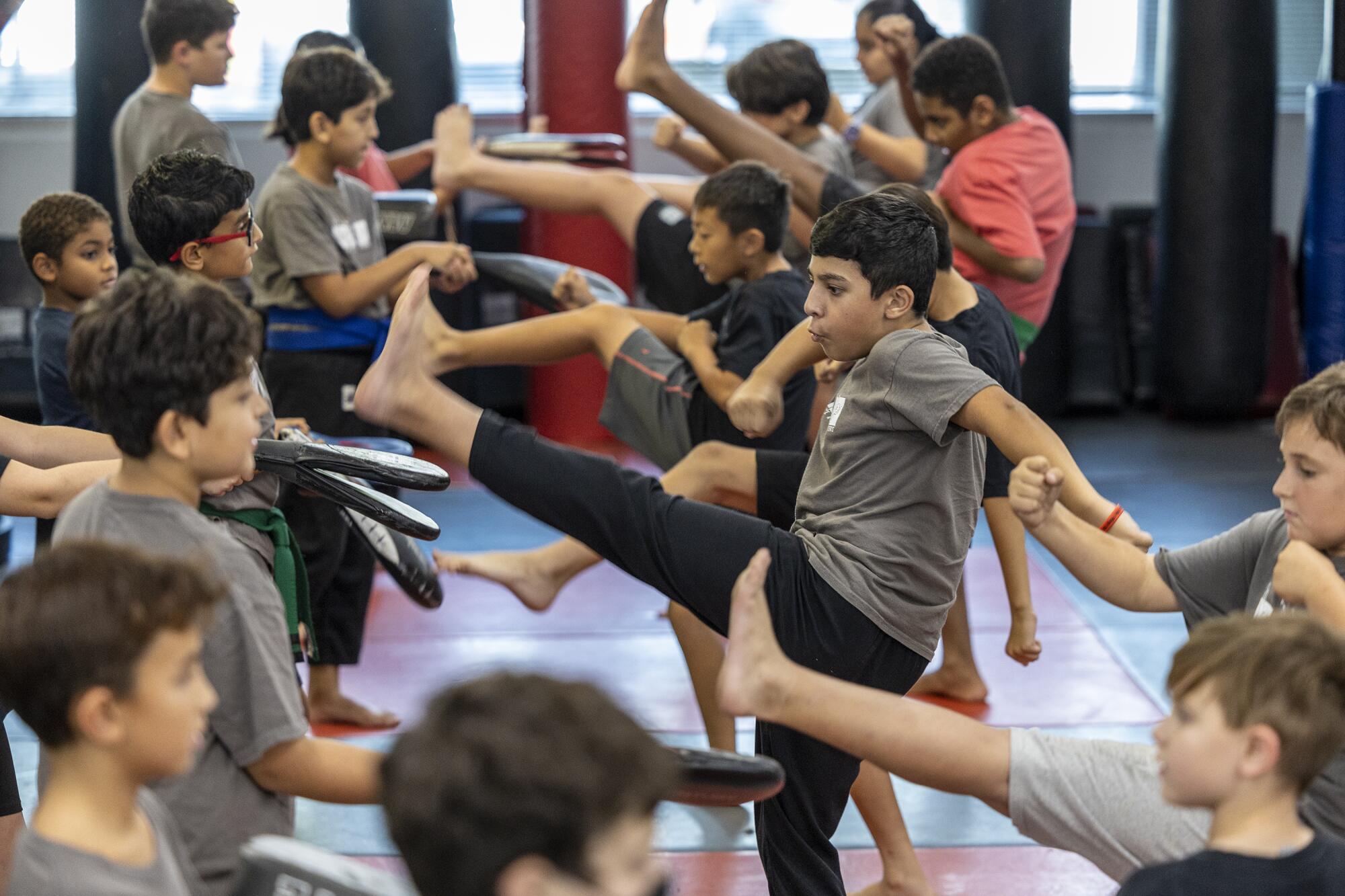
But his passion for karate never wavered. The excitement he felt from that first movie never went away.
These days, “Cobra Kai” is doing the same thing for a whole new generation.
Prior to the show’s premier in 2018, the karate industry had been in a malaise.
While there is no official governing body to track overall enrollment and participation, Matsuda cites several indicators that illustrate karate’s diminished reach.
The sport’s prominence declined in Hollywood productions. The once robust market of karate magazines and martial arts publications — such as one Matsuda used to publish — had nearly disappeared. And in places like the Valley, the vast network of neighborhood karate schools that used to seemingly populate almost every street corner and strip mall began to slowly disappear.
“It’s nothing like it used to be,” Matsuda said. “In my school, they had so many people I had to practice in the parking lot. There were many people in the schools. They were popping up everywhere. But since the movies are gone, the popularity isn’t the same.”
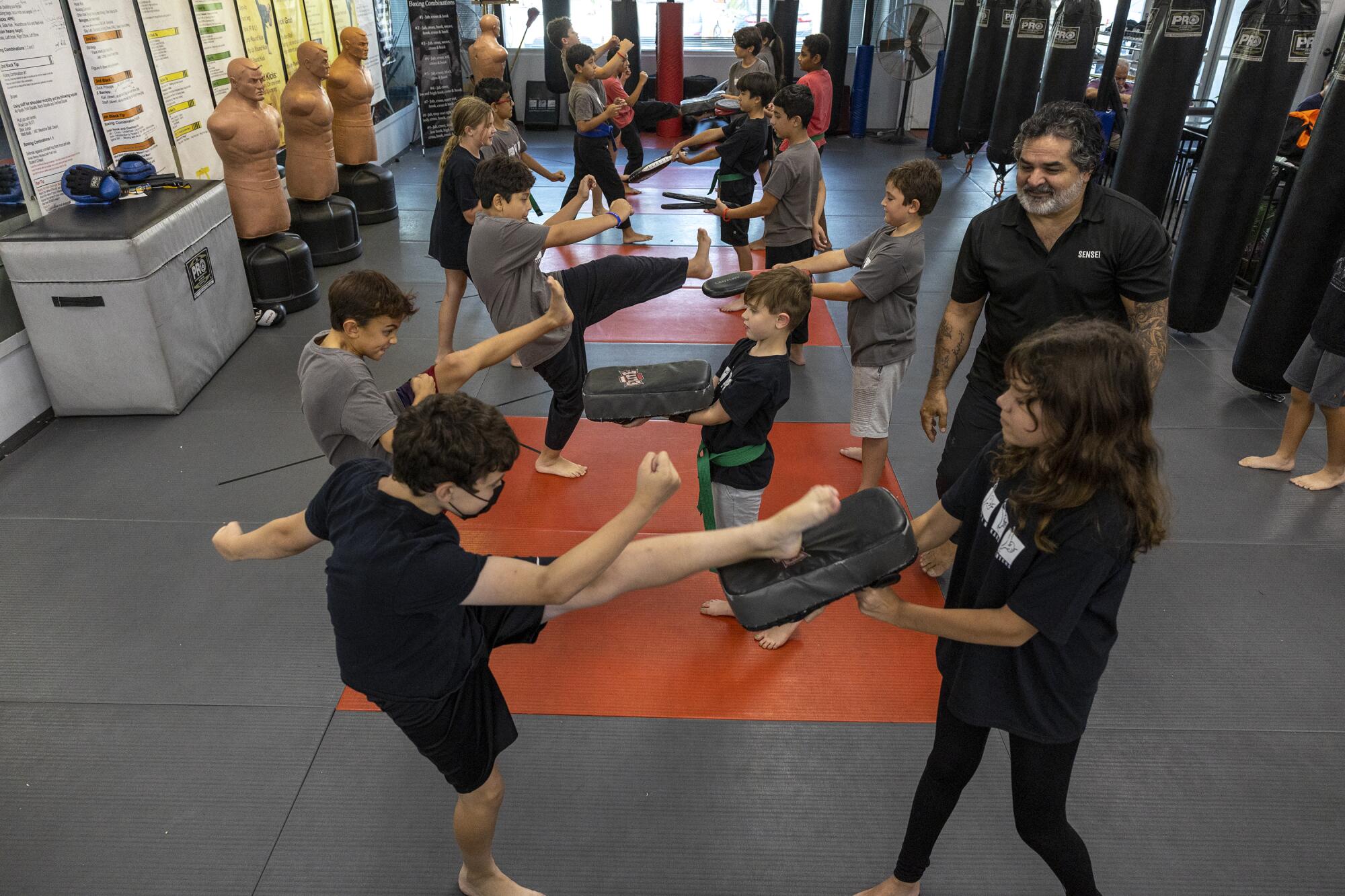
COVID-19 only exacerbated that trend.
Matsuda estimates that in Southern California alone, 80% of schools closed during the pandemic. Even successful dojos such as Azhakh’s, which prior to the pandemic had close to 1,000 students, have had their enrollment dwindle.
“Cobra Kai” helped reenergize interest, not only by putting a spotlight back on the visually astounding physical elements but also by exploring the philosophical complexities like its “Karate Kid” predecessor.
“[The show] is still talking about all the great stuff that martial arts can do, but they’re doing it in a modern way,” Azhakh said. “The honor, the bowing, the respect, wishing good upon your opponent, sportsmanship — things like ‘Cobra Kai’ push that back. That, ‘Hey, it’s important to kick ass, but you still got to be a nice person.’”
For all the ways it emulates the karate community, “Cobra Kai” still acts as more of a funhouse mirror.
Heated rivalries between actual dojos or instructors, like the ones in the “Karate Kid” universe, are rare. Instead, many instructors and school owners have worked together, connecting on social media to brainstorm best practices for their profession.
There’s mutual respect for different disciplines too. Azhakh has a sign in his studio that reads: “As far as other styles or schools are concerned, take no thought of who is right and who is wrong or who is better than, for in the landscape of spring … the flowering branches grow naturally.”
Tournament culture also isn’t nearly as fundamental to local karate schools as it is in the show, where much of the plot revolves around the annual “All Valley Championships.”
And the style of tournament fighting displayed in the show — characters wear no pads and fight with full contact and intensity — is more reminiscent of the so-called “blood and guts” era of the ‘60s and ‘70s than the carefully structured rules of most modern events.
“I don’t like a lot of the emphasis on tournaments,” said Bryan Hawkins, a Granada Hills instructor who takes his students to only one tournament every year. “It creates the wrong mindset, because it doesn’t translate to the street very well.”
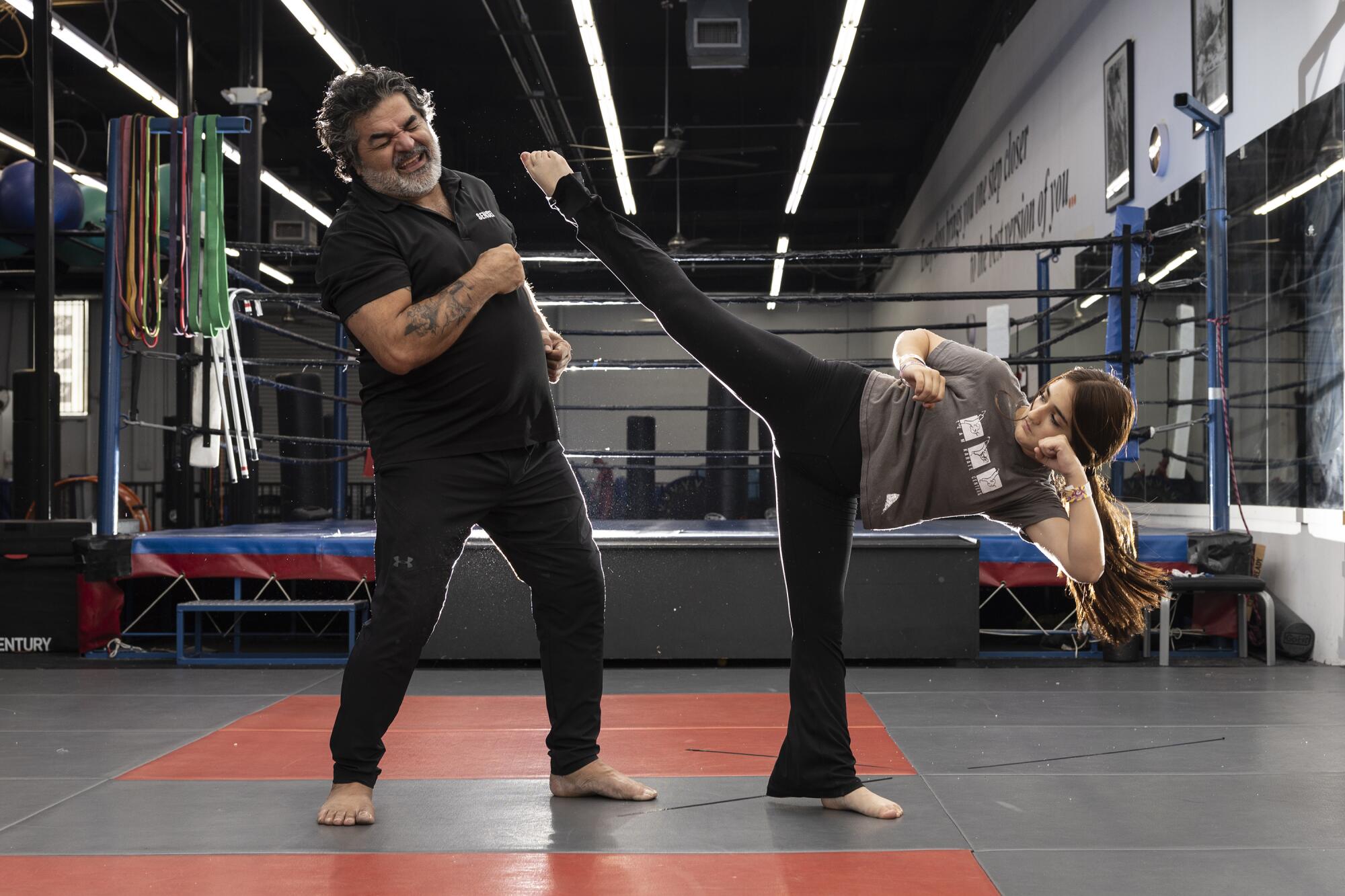
Nevertheless, what the “Karate Kid” movies helped portray and what “Cobra Kai” has brought back into focus have been relatable examples of the mental lessons and philosophical beliefs emphasized every time a student ties on their gi, bows before an instructor and takes the mat.
“I like the fact that the ‘Karate Kid,’ and now the ‘Cobra Kai’ series, is bringing back the philosophy,” Azhakh said.
And he isn’t even the biggest fan of the show in his family.
His 18-year-old daughter, Laila, is also an instructor at the school — and, amid a break during the recent youth class, lit up while talking about her attachment to the show and its relationship between Daniel and his teenage daughter, Samantha, in particular.
“I love ‘Cobra Kai,’” she said, “especially because of the father-daughter storyline.”
Laila returned to the mat, guiding a trio of young students through a series of exercises. First, she took them into a boxing ring where they performed kicks and strike combinations, the sounds of “hi-yas!” and heavy breaths again echoing around the room.
Then, they went to a set of monkey bars, where one girl fell to the mat with a thud. For a second, there was silence. But then, the young student leapt up, shared a quick laugh with her friends and hurried back to the start, ready to try again.
From the side, Laila smiled.
“That’s all right,” she shouted. “I’m most proud of you for trying.”
Watch L.A. Times Today at 7 p.m. on Spectrum News 1 on Channel 1 or live stream on the Spectrum News App. Palos Verdes Peninsula and Orange County viewers can watch on Cox Systems on channel 99.
More to Read
Go beyond the scoreboard
Get the latest on L.A.'s teams in the daily Sports Report newsletter.
You may occasionally receive promotional content from the Los Angeles Times.


